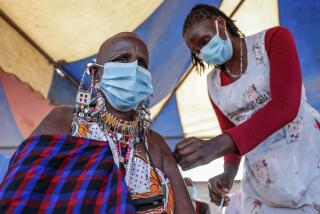Slowing the spread of AIDS
- Share via
FOR YEARS, EXPERTS HAVE worried that India could be the next epicenter of the AIDS epidemic. The world’s second-most-populous nation already has an estimated 5 million infected people, and some believed the country would soon have more AIDS cases than any other nation. But Indian researchers released some very surprising findings this week. The AIDS epidemic there appears to be slowing, especially in the south, where most infections occur.
This is good news for India, obviously. Because AIDS carries a heavy stigma in India, prevention efforts there historically have been difficult. And because most Indians don’t have access to anti-retroviral drugs, many of those who are infected die. But according to the new study, which appears in the British medical journal the Lancet, improved prevention messages and increased condom use in India are making a difference in slowing the disease’s spread.
But there may be even more good news than meets the eye. India’s recent success in taming its rate of new HIV cases could mean the rate of new infections around the world has finally peaked.
Here’s why. Along with China and Russia, India is part of what’s known as the “second wave” of the AIDS epidemic, behind “first wave” regions such as the U.S., Europe and Africa. Although it may surprise people, the number of new infections peaked in the U.S. and Europe in the 1980s, and in many parts of Africa in the late 1990s. Of course, because there is a long latency period after infection, the overall number of people living with the disease has continued to climb, as have the number of AIDS deaths worldwide.
Although the second-wave countries have high rates of HIV infection, they all have shown progress in moderating the number of new HIV cases. Because of India’s size and because it has such a higher number of infections, it has been a main focus of HIV experts around the world. Now that its rate of new cases appears to be slowing, HIV has few other places where it could continue to spread so rapidly.
Does these mean we should no longer be concerned about AIDS? Not exactly. This is only a small bit of good news in a large nightmare. In 2005, there were 5 million new cases worldwide (including 700,000 children), and more than 3 million people died of the disease. And even if the rate of new infections declines, the number of AIDS cases could continue to rise for several more years.
Plus, these are fragile gains. If countries (or the donor nations that support HIV prevention efforts) back off even a little bit in their efforts, new infections could easily begin climbing again.
What this does show, however, is that aggressive prevention efforts around the world can work, even in some of the poorest and most underdeveloped countries. It also means that the United States, which spends far more on the disease than any other nation, is making a substantial difference. In 2005, the U.S. spent $2.8 billion on AIDS worldwide, and the figure will be higher this year.






